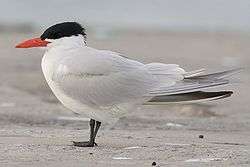Caspian tern
| Caspian tern | |
|---|---|
 | |
| Adult in summer plumage | |
| Scientific classification | |
| Kingdom: | Animalia |
| Phylum: | Chordata |
| Class: | Aves |
| Order: | Charadriiformes |
| Family: | Sternidae |
| Genus: | Hydroprogne Kaup, 1829 |
| Species: | H. caspia |
| Binomial name | |
| Hydroprogne caspia (Pallas, 1770) | |
| Synonyms | |
|
Sterna caspia | |
The Caspian tern (Hydroprogne caspia, formerly Sterna caspia)[2] is a species of tern, with a subcosmopolitan but scattered distribution. Despite its extensive range, it is monotypic of its genus, and has no subspecies accepted either.[3] In New Zealand it is also known by the Maori name taranui.
Description
It is the world's largest tern with a length of 48–60 cm (19–24 in), a wingspan of 127–145 cm (50–57 in) and a weight of 530–782 g (18.7–27.6 oz).[3] [4] Adult birds have black legs, and a long thick red-orange bill with a small black tip. They have a white head with a black cap and white neck, belly and tail. The upper wings and back are pale grey; the underwings are pale with dark primary feathers. In flight, the tail is less forked than other terns and wing tips black on the underside.[3] In winter, the black cap is still present (unlike many other terns), but with some white streaking on the forehead. The call is a loud heron-like croak.[5]
Distribution and habitat
Their breeding habitat is large lakes and ocean coasts in North America (including the Great Lakes), and locally in Europe (mainly around the Baltic Sea and Black Sea), Asia, Africa, and Australasia (Australia and New Zealand). North American birds migrate to southern coasts, the West Indies and northernmost South America. European and Asian birds spend the non-breeding season in the Old World tropics. African and Australasian birds are resident or disperse over short distances.[3]
The global population is about 50,000 pairs; numbers in most regions are stable, but the Baltic Sea population (1400–1475 pairs in the early 1990s) is declining and of conservation concern.[3][6]
The Caspian tern is one of the species to which the Agreement on the Conservation of African-Eurasian Migratory Waterbirds (AEWA) applies.
Behaviour
Feeding
They feed mainly on fish, which they dive for, hovering high over the water and then plunging. They also occasionally eat large insects, the young and eggs of other birds and rodents. They may fly up to 60 km (37 mi) from the breeding colony to catch fish; it often fishes on freshwater lakes as well as at sea.[3][5]
Breeding
Breeding is in spring and summer, with one to three pale blue green eggs, with heavy brown spotting, being laid. They nest either together in colonies, or singly in mixed colonies of other tern and gull species. The nest is on the ground among gravel and sand, or sometimes on vegetation; incubation lasts for 26–28 days. The chicks are variable in plumage pattern, from pale creamy to darker grey-brown; this variation assists adults in recognizing their own chicks when returning to the colony from feeding trips. Fledging occurs after 35–45 days.[3]
Gallery
-

Preparing for takeoff
-

Caspian tern in flight
-

Two Caspian terns in flight
-
A vagrant Caspian Tern seen in Hoskote lake, Bangalore
References
- ↑ BirdLife International (2012). "Sterna caspia". IUCN Red List of Threatened Species. Version 2013.2. International Union for Conservation of Nature. Retrieved 26 November 2013.
- ↑ Bridge, E. S., Jones, A. W., & Baker, A. J. (2005). A phylogenetic framework for the terns (Sternini) inferred from mtDNA sequences: implications for taxonomy and plumage evolution. Molecular Phylogenetics and Evolution 35: 459–469. PDF file
- 1 2 3 4 5 6 7 del Hoyo J., Elliott, A., & Sargatal, J., eds. (1996). Handbook of the Birds of the World 3: 645. Lynx Edicions ISBN 84-87334-20-2.
- ↑ "Wild About Terns: Looking After Our Shorebirds" (PDF). Department of the Environment and Climate Change NSW.
- 1 2 Mullarney, K., Svensson, L., Zetterström, D., & Grant, P. J. (1999). Collins Bird Guide. Collins ISBN 0-00-219728-6.
- ↑ Snow, D. W., & Perrins, C. M. (1998). The Birds of the Western Palearctic Concise Edition OUP ISBN 0-19-854099-X.
- Burnie, David & Wilson, Don E. (editors) (2001): [Caspian Tern]. In: Smithsonian Institution Animal: The Definitive Visual Guide to the World's Wildlife: 307. Washington DC & New York, Smithsonian Institution & Dorling Kindersley Publishing. ISBN 0-7894-7764-5
- Collinson, M. (2006). Splitting headaches? Recent taxonomic changes affecting the British and Western Palaearctic lists. British Birds 99(6): 306-323.
- Falla RA, Sibson RB & Turbot EG (1966) A Field guide to the birds of New Zealand. Collins, London (ISBN 0-00-212022-4)
- Harrison, Peter (1988): Seabirds (2nd edition). Christopher Helm, London ISBN 0-7470-1410-8
- National Geographic Society (2002): Field Guide to the Birds of North America. National Geographic, Washington DC. ISBN 0-7922-6877-6
- Sibley, David Allen (2000): The Sibley Guide to Birds. Alfred A. Knopf, New York. ISBN 0-679-45122-6
External links
| Wikimedia Commons has media related to Caspian tern. |
| Wikispecies has information related to: Hydroprogne caspia |
- Caspian Tern - Species text in The Atlas of Southern African Birds
- Caspian Tern videos, photos, and sounds at the Internet Bird Collection
- Caspian Tern photo gallery at VIREO (Drexel University)
- Interactive range map of Hydroprogne caspia at IUCN Red List maps
